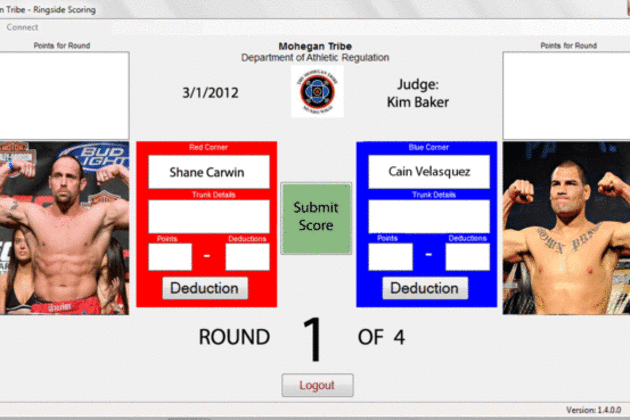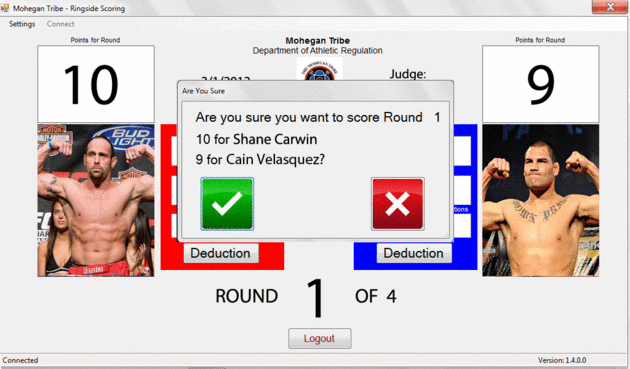
It was about one month ago when Demetrious Johnson and Ian McCall fought a match that was supposed to send the winner to a championship bout. Because the match was contested under a tournament format, the UFC had thought to add an unprecedented clause providing for an overtime-style fourth round in case of a draw.
Despite seemingly having all their bases covered, the UFC was robbed of a victor that night due to simple math error that led to an incorrect decision. By the time the mistake was discovered, it was too late to correct. Instead of fighting an overtime round, Johnson and McCall will have to rematch.
The mistake angered many, with UFC president Dana White memorably asking commissions to “get a f—ing calculator.” According to one athletic commission, that blunder would have never happened on their watch. Why? Because they are already utilizing a new scoring application that takes human error out of the equation wherever possible, and they are hoping to spread the technology throughout both MMA and boxing.
The new system, tentatively named “Ringside Scoring,” was created by the Mohegan Tribe Department of Athletic Regulation in Connecticut. It is essentially an electronic application that replaces the longtime standard paper and pencil.
Each judge is given a wireless, touch-screen pad that can only be unlocked by a personal code. During an event, a commission rep will have control of a mainframe that will display the current bout on each judges’ pad. Readouts will include photos of the respective fighters in the blue and red corners, while extra identifying information including shorts colors can be added as well.
At the conclusion of a round, judges will be prompted to enter their score, and asked to verify it a second time before transmitting. The mainframe computer then tabulates scores round by round.
According to the department’s director Michael Mazzulli, the Mohegan tribe, which has patented and copyrighted the system, originally conceived the design about four years ago with the goal of “moving boxing and MMA into the 21st century.”
The program was written by information technology specialist Michael Spellman in 6-8 months, and the tribe has quietly used it for events ever since, making changes and addressing issues along the way. But after tinkering with it for three years, it’s reached maturity, according to Mazzulli.
“I’m 99.9 percent confident that this is going to always work,” he said. “We’ve always had paper backup, but I’m at the point today where I don’t think we need paper backup. We’ll always have it because it’s easy, but this is a great system.”
During last year’s Association of Boxing Commissions meeting, Mazzulli demonstrated it for several in attendance. At that time, even though reception was strong, the system was not quite ready to be spread. Now it is. They’ll soon demonstrate it to other Native American athletic commissions and make it available for purchase.
One prospective issue in spreading the technology is cost. According to Mazzulli, the hardware and computer costs between $3,800-$4,000, but the tribe is discussing ways to make it more affordable or to lease it.
“We’re not looking to make money,” said Mohegan Tribe information systems chief information officer Chuck Scharnagle. “There aren’t thousands of commissions to sell it to. This is just an opportunity for Mohegan to help spread its brand and help boxing and MMA.”
Because of the time they’ve spent developing the system, it has safeguards in place for security and has been designed for ease of use in scoring. When it comes to the latter, things like point deductions have been integrated, while the administrator in charge of the main computer can view scoring in real time for any inconsistencies.

[Safeguards in place ensure accuracy with the Mohegan Tribe’s “Ringside Scoring” system. Photo by Michael Spellman]
“There’s no real way to interfere with the judges’ cards, but we can watch for impropriety,” Spellman said. “If we have two judges scoring the bout 10-9, 10-9, 10-9, and one judge is scoring it 9-10, 9-10, 9-10, we have the opportunity to walk up to him between rounds and say, ‘Is everything going OK?’ just to make sure everything is on the up and up.”
When a fight concludes, the scores are automatically tabulated, or in the instance of a finish, the mainframe administrator can choose from a list of stoppage methods, including KO, TKO and over 45 submission varieties including little-seen ones like the Twister, Peruvian necktie and Electric Chair.
The computerized aspect would allow for accurate results far faster than the current system, and because it was designed to be intuitive, a tutorial for new users would likely only take minutes. Given the sports’ young demographic, a future version may include some type of interactive element, as well, according to the creators.
The one downside? It’s still up to the judges to interpret what they see and then key in a score. But at least we wouldn’t have to worry about them being tabulated incorrectly. It’s only happened a few times in MMA history, but given the rising stakes of high-level MMA, it shouldn’t happen at all.
“The bottom line is, paper and pencil are cheaper and easier in some respects, but at the end of the day, these things are getting to be bigger and bigger events,” Scharnagle said. “You don’t want a mistake over one point. Something like this prevents that from happening. The scores are in right away. There’s no handwriting to figure out. Everything flows faster than it normally would.”